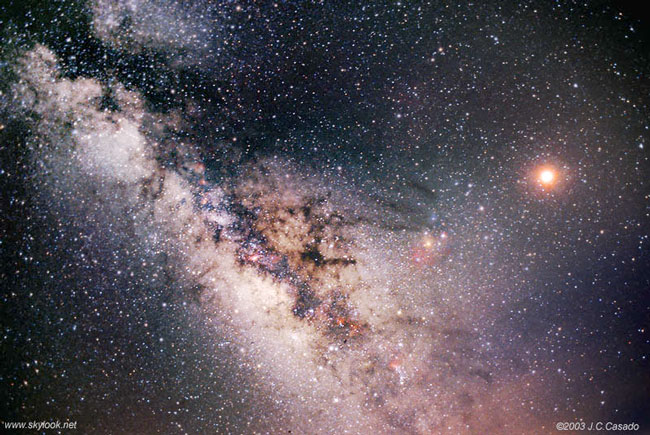
|
Credit & Copyright: Juan Carlos Casado
Explanation:
What's behind the Moon? Each month,
our Moon passes in front of --
and outshines -- many an interesting star field.
Exceptions occur during a
new Moon and during a
total eclipse.
In the background of a new
Moon
is usually the Sun, an even brighter orb that even
more easily outshines everything behind it, except during a
total solar eclipse.
Even the longest total solar eclipse
lasts just a few minutes, while the
Sun's corona still remains bright.
During a total lunar eclipse,
however, the full Moon
dims and a majestic star field may present itself for an hour or more.
Such was the case during the middle of last month,
when a rare glimpse of an eclipsed Moon superposed in front of the disk of our home
Milky Way Galaxy was captured.
Although fully in the Earth's shadow, the eclipsed Moon is still the
brightest object on the right.
The above image was captured during sub-zero weather from the
Teide 2003 expedition to
Mirador del Pico Viejo, a mountain in the
Canary Islands,
Spain, off the northwest coast of
Africa.
|
January February March April May June July August September October November December |
| |||||||||||||||||||||||||||||||||||||||||||||||||||||||
NASA Web Site Statements, Warnings, and Disclaimers
NASA Official: Jay Norris. Specific rights apply.
A service of: LHEA at NASA / GSFC
& Michigan Tech. U.
Based on Astronomy Picture
Of the Day
Publications with keywords: eclipse - Moon - Milky Way
Publications with words: eclipse - Moon - Milky Way
See also:
- APOD: 2025 August 23 Á Fishing for the Moon
- APOD: 2025 July 20 Á Lunar Nearside
- APOD: 2025 July 2 Á Milky Way Through Otago Spires
- APOD: 2025 June 28 Á Lunar Farside
- APOD: 2025 June 20 Á Major Lunar Standstill 2024 2025
- APOD: 2025 June 18 Á Space Station Silhouette on the Moon
- APOD: 2025 May 20 Á Milky Way over Maunakea
